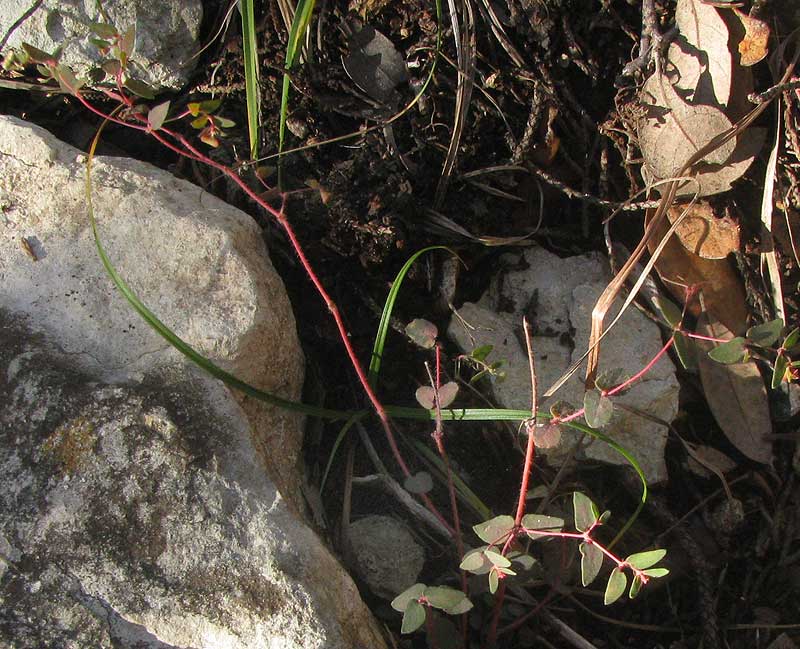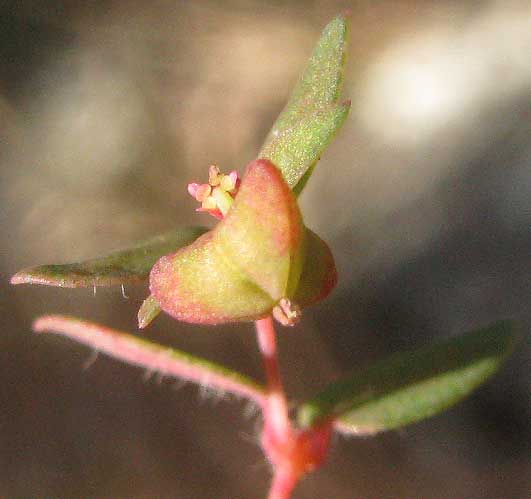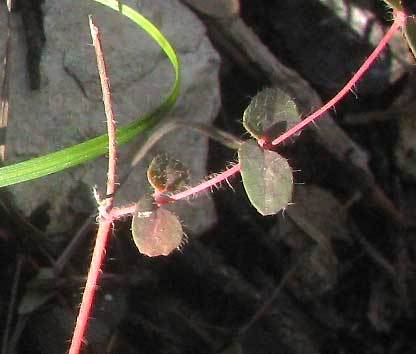Excerpts from Jim Conrad's
Naturalist Newsletter

from the December 29, 2013 Newsletter issued from the Frio Canyon Nature Education Center in the valley of the Dry Frio River in northern Uvalde County, southwestern Texas, on the southern border of the Edwards Plateau; elevation ~1750m (~5750 ft); N29.62°, W99.86°; USA
HAIRY EUPHORBIA
Despite several recent hard freezes, here and there you can still find wildflowers blooming, mostly commonly occurring members of the Composite or Daisy Family. However, I look for species I've not noticed before, and this week I felt sure there'd be none of those. However, a new one did show up, a small, very modest looking, scraggly herb with most of its stem leaves fallen off, growing in an especially well sheltered spot between limestone rocks on the south face of our hill, shown above.
With those opposite leaves -- two leaves per stem node -- and the leaves' shape and the way they tend to cluster at stem tips, already many folks will recognize this as a kind of euphorbia, also called spurge or sandmat. Very many euphorbia species exist, but all share an unusual and distinctive flower anatomy. Just to make sure it was a euphorbia I looked for a blossom, which was hard to find because it was so small. You can see it below:

The three-cornered, reddish item in the middle of the picture is the ovary and future capsule-type fruit. It's on a short stalk arising from a cuplike structure known as the cyathium, and inside the cyathium reside maybe four male flowers. In other words, among the euphorbias there are separate male and female flowers, but the various flowers are arranged into a blossom-like head with tiny, much-reduced male flowers inside the head, or cyathium, and with the single female flower banished outside. That weird anatomy is shared by all euphorbias.
Plants known as euphorbias belong to the genus Euphorbia. Our plant is the Hairy Euphorbia, EUPHORBIA VILLIFERA, and besides its small size -- its leaves are only about 3/8ths inch long (1cm) -- and the leaves' short, broad shape, and the stems' redness, the main field mark for this species is its sparse covering of fairly long, soft hairs, as shown below:

Many euphorbia species are weedy and widely distributed, but some are true wildflowers, and some are even rare. That's the case with the Hairy Euphorbia, which is endemic only to the southern border of the Edwards Plateau in Texas and in arid northern Mexico.
The Hairy Euphorbia's vegetative parts issue white, milky juice when damaged, but that's typical of the euphorbias. In general, euphoriba latex contains powerful and sometimes toxic chemicals, but this species is so small and spindly that that's of little consideration here. One can imagine small sparrows gladly pecking at its fruits.